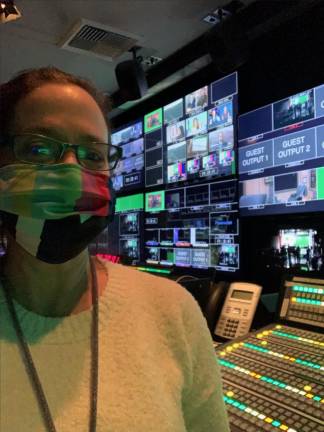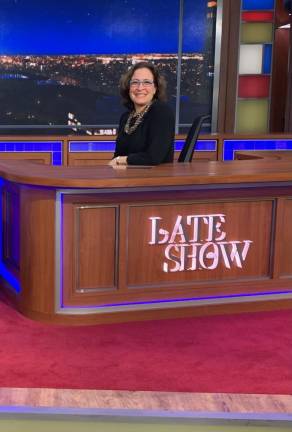Have you ever wondered how television gets made? Well it’s not as simple as pushing a few buttons. I had the opportunity to interview Karen Cape, the technical director of “The Late Show with Stephen Colbert,” who told me all about this complicated and highly skilled position.
What does a technical director do?
As the technical director, I push the buttons that put the show on the air and I oversee the technical crew. I work in a room with no windows and what looks like a wall of flat screen TVs. My console of buttons – called the switcher – looks like it would control the space shuttle as there are A LOT of buttons of all different colors and each button corresponds to something that can go on the air like a camera or graphic or playback video source. I am part of the team that implements the producers’ vision of the show: simply put, the producers and writers conceive of and create the elements of the show and the technical production team led by the director puts all of the pieces together.
What’s the best part of your job?
I’d say it’s the fact that I get paid to work on a show that I would watch anyway. “The Late Show with Stephen Colbert” is very fun and newsy, which is definitely my type of show. Also, it’s absolutely lovely to work with people who I’ve known within the industry for decades.
Describe the control room environment.
Imagine NASA during a rocket ship takeoff. Even though the show is taped, we always act as though it’s live. On the rare occasion that Stephen Colbert decides to redo a joke, something that he often says is, “Please do enjoy these jokes a second time. I find that comedy is much fresher when you know what’s coming.” The control room really enhances everyone’s focus. It’s fun yet challenging and despite what people might think, it’s actually fairly calm because the whole room is filled with seasoned professionals. For a while, we weren’t in studio at all, due to COVID, but we’ve started to come back slowly. Initially, it was just me and the director, so it was much quieter than it used to be.
How did you get into TV?
Today, the control room staff actually had a meeting with some interns to discuss that very question. It’s interesting, each person has had a different path to their position. I went to a liberal arts college and received a great general education. When I left college, I was interested in both law and broadcasting, but I wasn’t certain that I wanted to be a lawyer for the rest of my life. CNBC was just launching at the time and were willing to hire young people with little experience and trained them in any number of jobs they were interested in doing. I worked as a technical person, doing camera operation, commercial playback, really every job other than audio. Having held all those positions, I think, makes me a much better technical director because I understand what it takes to do the jobs that the people I now oversee do.
How long does it take to get hang of it?
I’ve been a technical director for over 30 years, with a seven-year stint directing the Jerry Springer Show. Obviously, the amount of time it takes to learn the ropes differs from person to person based on the kinds of shows someone does at the beginning of their career. Based on my experience, because of the news and talk shows I worked on, I got to work different parts of my brain and that creativity made me a better technical director. However, the technical part is only about 10% of my job. The other 90% is managing people and their personalities. The nature of the relationships and simple interactions I have with the people I manage and work with, can make my day much better or worse.
Are there many female technical directors?
There are still fewer women than men, but there are far more than there used to be when I started in TV in 1989. A few years later, when I moved networks, a few wonderful women took me under their wing and advised me and supported me. Now, I try to give back by helping and supporting young people in television.
What advice would you give someone wanting to go into TV?
If I could give any advice, it would be to talk to as many people as you can about what you want to do so that you have a better chance of getting your foot in the door. Also, be willing to do any reasonable, low-level job, as long as you are respected, and be excited to be exposed to many different areas of production. Even if you’re bringing coffee or deliveries, you will get the opportunity to see how different departments work. Additionally, make sure to show enthusiasm so that when positions open up, you will be thought of to fill that position. Ask people in areas or departments you’re interested in how they got to where they are and don’t let people take advantage of you. Remember, patience and persistence are key. Sometimes it takes people a while to get back to you, but make sure to let people know that you’re there. Lastly, since the internet makes applying for jobs very easy and therefore standing out is harder than it used to be, make sure to use your connections.
How did you handle COVID?
A lot of industries ended up relying heavily on technology for communication. Zoom and other virtual meeting companies were huge and we also took advantage of their services. We were all working from home in many different states. Despite being in the business for several decades, I had never seen or experienced anything like what we had to do to get our show on the air during COVID. I found the new uses of new and old technology fascinating, pushing buttons on my laptop in pajamas in the Berkshires. All of us who were working from home enhanced our Wi-Fi as this was the only way we could communicate with each other and assemble the show remotely. We worked very hard to make a version of the show like it was before COVID. It’s been very challenging, but also very fascinating and rewarding. We’re all very happy to get back in the control room. We’re not back 100% yet, but at the moment we’re about 85% to 95% back.
Lea Efran is a NYC high school sophomore. She plays volleyball, does jiu-jitsu and is a Stone Soup Magazine honoree.

